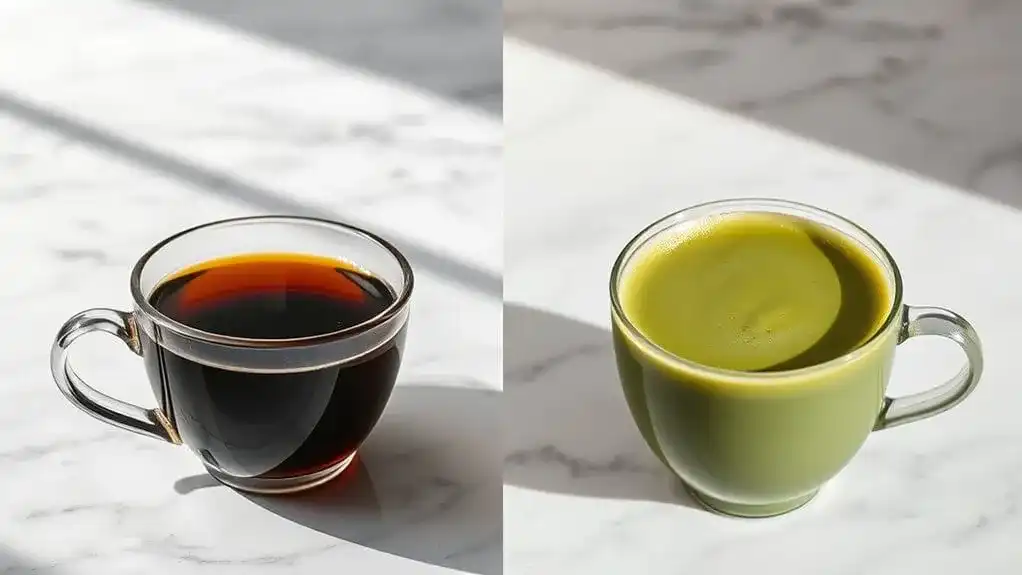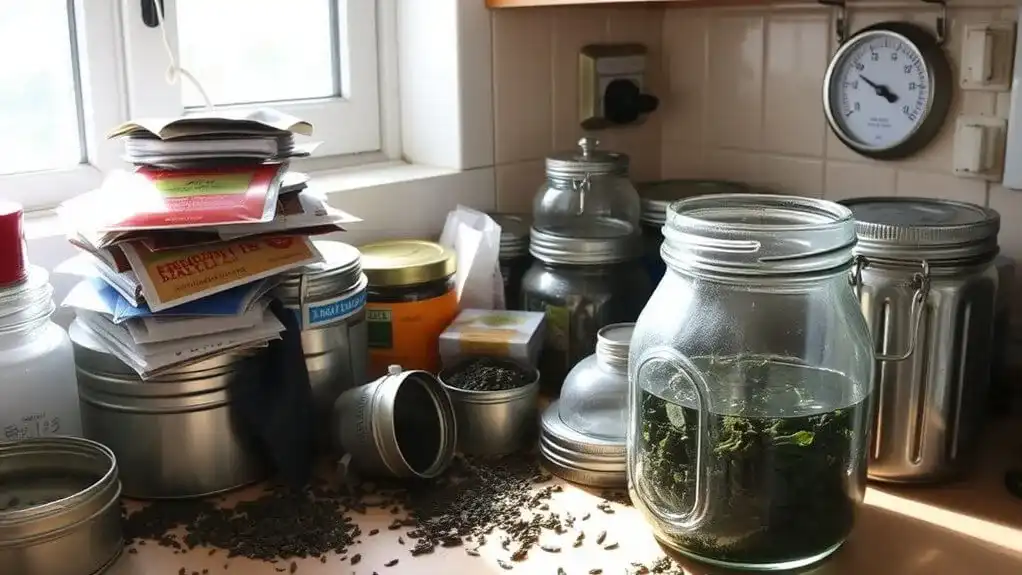A person's tea preferences reveal fascinating details about their taste buds and genetic makeup. Their sensitivity to bitterness, influenced by specific genetic variants, can determine whether they enjoy strong black teas or prefer milder varieties. Women's taste buds tend to be more genetically influenced than men's, while age and cultural background also shape tea choices. This complex interplay of factors makes each person's tea experience uniquely their own, with deeper layers waiting to be discovered.
Key Points
- Genetic variations in bitter taste receptors directly influence whether you enjoy or avoid certain types of tea.
- Your caffeine metabolism rate accounts for 42% of your tea preferences and beverage choices.
- Women typically have stronger genetic influences on their tea preferences compared to men.
- Age-related changes in taste buds and sensory perception can shift tea preferences, especially after age 60.
- Tea preferences often correlate with personality traits, with black tea drinkers showing confidence and green tea enthusiasts being health-conscious.
The Genetic Blueprint Behind Your Tea Choices
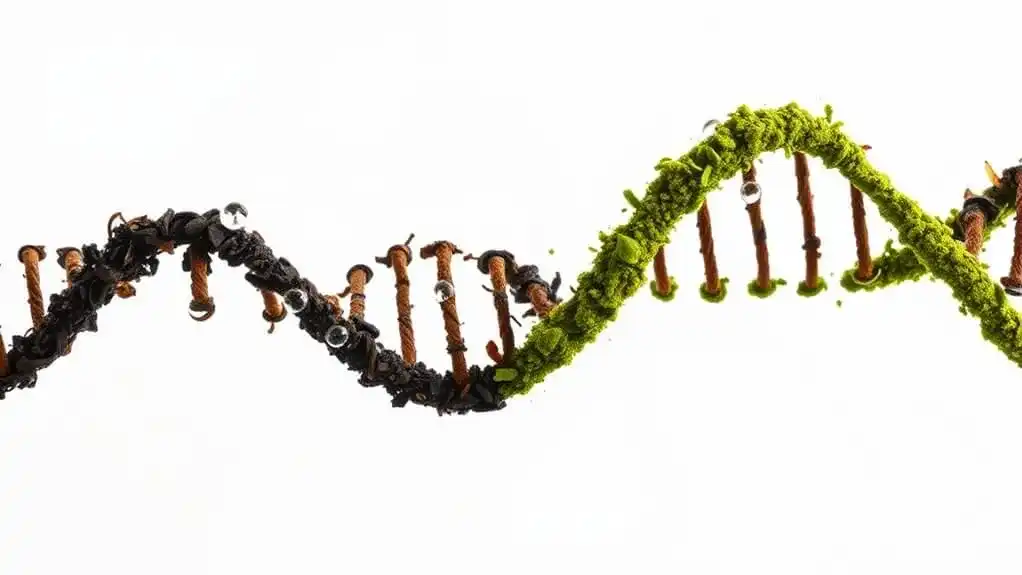
While many people assume their tea preferences are purely a matter of personal taste, scientific research reveals that genetic factors play a substantial role in determining these choices. Specific genetic variants affecting bitter taste receptors strongly influence whether someone becomes a tea enthusiast or not.
Studies show that people with certain variants in their quinine or PROP receptor genes are more likely to be avid tea drinkers. In fact, each additional copy of these genes increases the likelihood of consuming more than five cups daily by up to 9%. Women's tea preferences are particularly influenced by genetics compared to men's. Those who are sensitive to PROP often gravitate toward tea instead of coffee, as they find tea's subtle bitter notes more appealing than coffee's intense bitterness. Research has demonstrated that caffeine metabolism rate accounts for approximately 42% of overall beverage preference choices. The study was limited by focusing primarily on white British ancestry, which may not represent broader population preferences.
How Your Brain Adapts to Different Tea Flavors
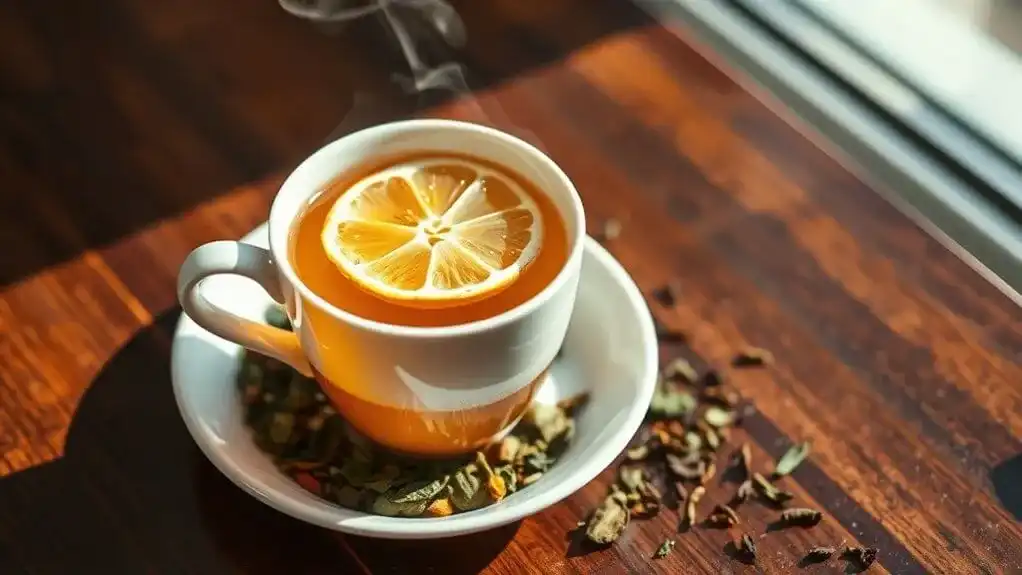
Beyond genetic predispositions, the human brain exhibits remarkable adaptability in processing and interpreting tea flavors. When someone sips tea, their brain orchestrates a complex symphony of sensory inputs, combining taste, aroma, and mouthfeel through a process called flavor adaptation. This multisensory experience activates both the gustatory and olfactory systems, creating unique flavor profiles that become stored in sensory memory. Recent studies show that even experts struggle to identify blended components when tasting complex flavor combinations. The outer brain layer is particularly active during conscious tea tasting, enabling sophisticated flavor analysis and decision-making.
The brain's limbic system plays an essential role by connecting tea experiences to emotions and memories through the amygdala and hippocampus. Meanwhile, compounds like caffeine and L-theanine work together to enhance cognitive performance, while polyphenols provide neuroprotective benefits. Regular consumption of green tea can boost brain wave activity, particularly in alpha, beta, and theta frequencies, leading to enhanced cognitive function. As tea drinkers develop their palates, their brains become more adept at distinguishing subtle flavor variations, making each cup a more nuanced and rewarding experience.
The Role of Age and Gender in Tea Taste Perception

Although taste perception varies among individuals, age and gender play essential roles in how people experience tea flavors. Age effects considerably impact taste thresholds, with elderly individuals showing decreased sensitivity across all taste qualities. The aging perception of tea becomes less distinct as people get older, partly due to a 20-60% loss in taste buds after age 60. Research indicates that elderly adults experience flatter response curves when tasting sweet and bitter compounds.
Olfactory influence accounts for roughly 70% of age-related differences in taste perception, highlighting how vital smell is to the overall tea experience. Gender differences also shape tea appreciation, particularly through sensory interactions with teacup preferences. The width, height, and texture of teacups affect how different genders perceive tea's taste and aroma. Studies show that Westerners tend to have more abstract perception when evaluating tea flavors compared to other populations. As people age, preference shifts occur, though relative taste discrimination remains somewhat resilient despite declining absolute perception abilities.
Your Teacup's Hidden Impact on Flavor Experience
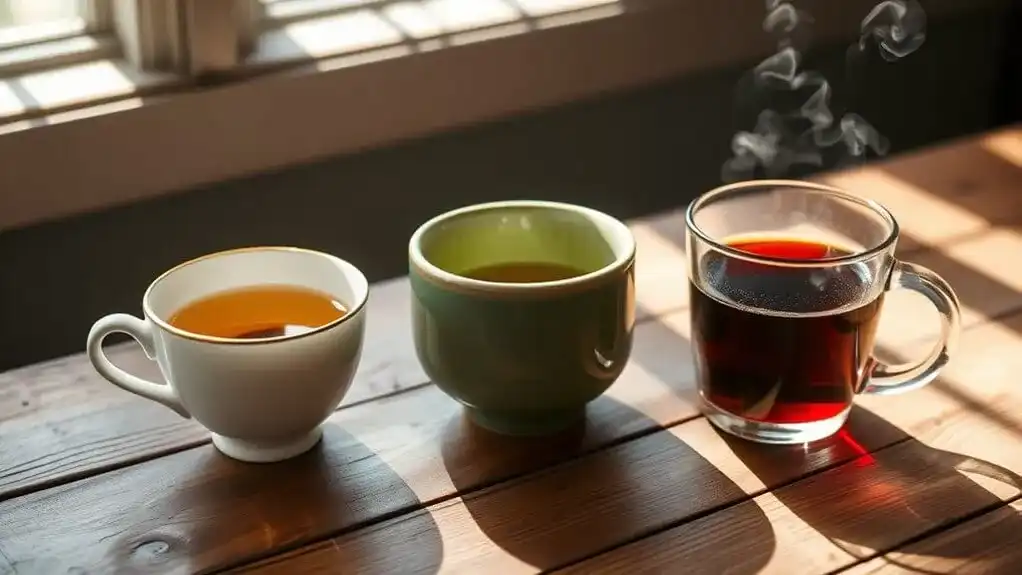
Have you ever considered how your choice of teacup shapes your tea-drinking experience? Teacup geometry plays an important role in flavor intensity, with wider cups distributing taste evenly across the tongue while narrower ones concentrate specific notes. The rim design affects how aromas are released, as thicker rims enhance astringency and richness, while wider openings allow fragrances to disperse more freely.
Surface finish greatly influences tactile perception and taste. Smooth surfaces heighten the detection of umami and sweetness, while granular textures intensify astringency. Traditional Chinese tea cups employ handle-less designs to create a more intimate connection with the tea through touch and temperature. Even color influence can't be overlooked, as it affects overall preference variation among tea drinkers. Research shows that these subtle design elements work together to create distinct drinking experiences, making your choice of teacup an essential factor in how you perceive your tea's complex flavors. Ancient Chinese philosophers believed that the ritual of tea drinking represented a harmony with nature, reflecting deeper cultural connections to language and tradition.
The Psychology of Tea Drinking and Taste
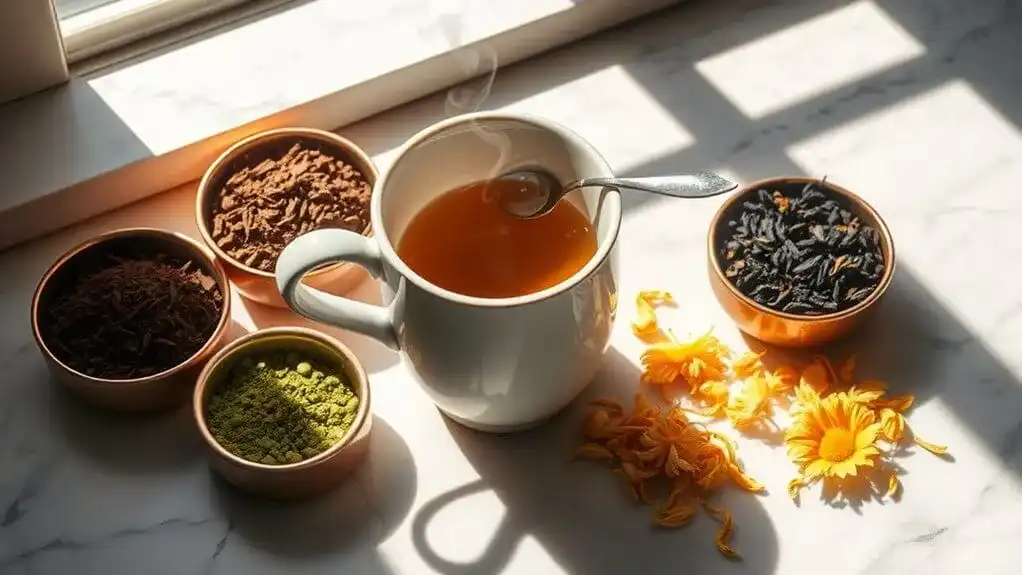
While teacup design shapes our physical experience of tea, the psychology behind tea preferences reveals an intricate relationship between our genes, personality, and taste perceptions. Research shows that genetic variations influence how we detect bitterness, with tea drinkers often being more sensitive to certain bitter compounds while showing less sensitivity to caffeine's bitter notes. A comprehensive study examining over 400,000 participants demonstrated clear genetic patterns in beverage preferences. Studies indicate that tea selection reflects a person's determination and positivity. Tea choices also serve as a personality reflection, with different varieties attracting distinct psychological profiles. Black tea drinkers tend to be resilient and confident, while green tea enthusiasts exhibit calm and health-conscious traits. Those who prefer chai tea often display a sassy personality, reflecting their desire for uniqueness. Cultural influences play a significant role too, as tea preferences often align with specific cultural norms and values. This complex interplay between genetics, personality, and cultural background demonstrates that our tea choices aren't merely about taste—they're a window into our psychological makeup.
Understanding Your Personal Tea Sensitivity Profile
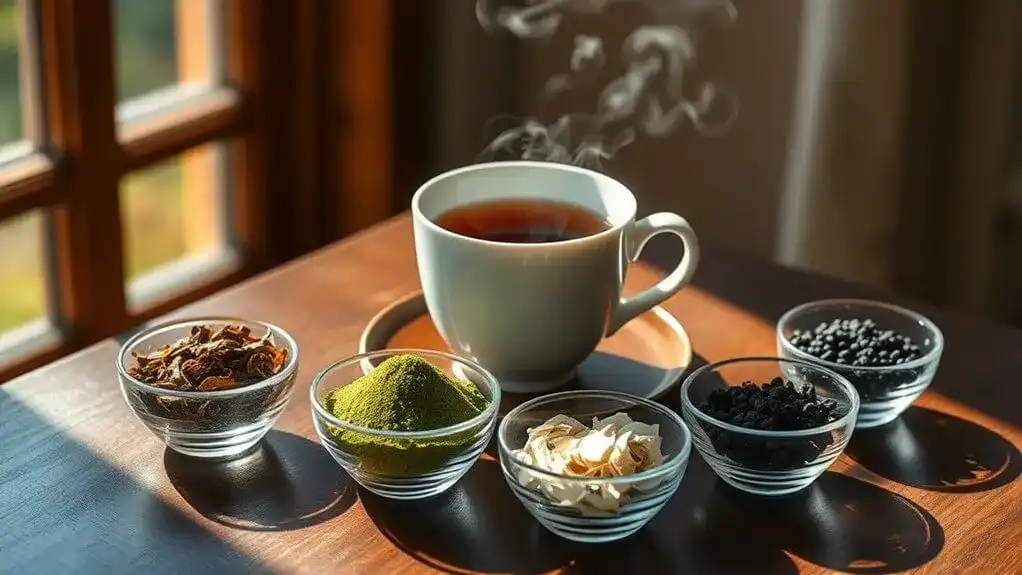
Understanding your body's response to tea requires careful attention to potential sensitivities and allergic reactions that can range from mild discomfort to severe health emergencies. Tea allergies can manifest through respiratory issues, skin problems, or digestive sensitivity, with symptoms varying from person to person. Clinical testing can help identify specific tea allergies through blood sampling. Since tea leaves primarily consist of complex polyphenols, individual reactions can vary based on these specific compounds.
Your personal tea sensitivity profile isn't static – environmental factors, stress levels, and previous exposure can influence how your body reacts to different teas. Natural compounds in tea can help manage allergic conditions through immunomodulatory effects. While traditional tea may trigger reactions in some people, herbal alternatives might offer a safe option. It's essential to work with healthcare providers to identify specific triggers through proper testing and develop an appropriate management plan. Being aware of cross-reactivity with other foods and carefully reading ingredient labels can help prevent unexpected reactions when exploring different tea varieties.
Unlocking Your Tea Palate Through Sensory Training

To develop a sophisticated tea palate, sensory training offers a systematic approach that engages multiple senses beyond just taste. Through careful practice of sensory techniques like slurping, chewing, and retronasal breathing, tea enthusiasts can reveal deeper layers of flavor and enhance their tasting abilities. Following a printed training wheel can help participants systematically track and describe the intensity of different flavor notes they experience.
The process begins with mastering fundamental taste enhancement methods. The slurping technique introduces oxygen to cool the tea and amplify its notes, while the chewing method reveals subtle variations in mouthfeel. Breathing out through the nose after swallowing helps uncover hidden flavors through retronasal sensation. These practices, combined with focused attention to touch and aroma, create a thorough sensory experience. Quality teas display their excellence through complex aftertastes that linger pleasantly after each sip. Even visually impaired individuals often excel in tea appreciation, as their heightened sense of smell and taste can lead to exceptional ability in distinguishing tea varieties. With dedicated training, tea enthusiasts can learn to identify growing regions of tea within just a few weeks of practice.
Conclusion
By a fascinating coincidence, the same genetic markers that influence someone's tea preferences also play a role in their perception of bitter greens and dark chocolate. While science can't predict with absolute certainty which tea a person will love, it's clear that taste preferences aren't random – they're a complex dance between genetics, experiences, and even the vessels we choose to drink from.
